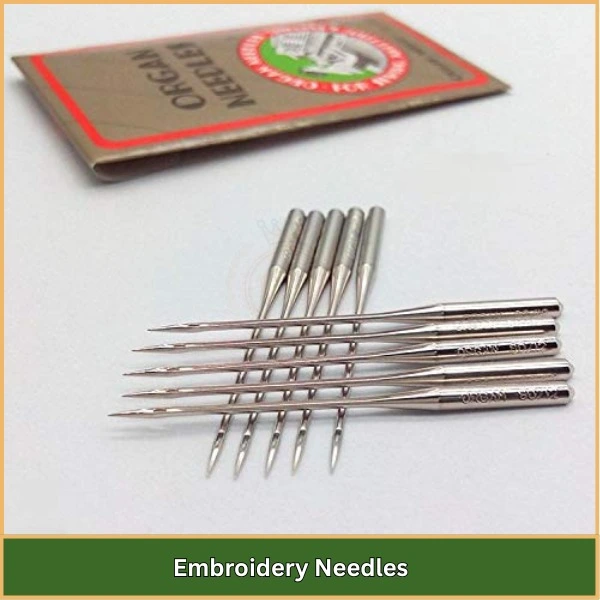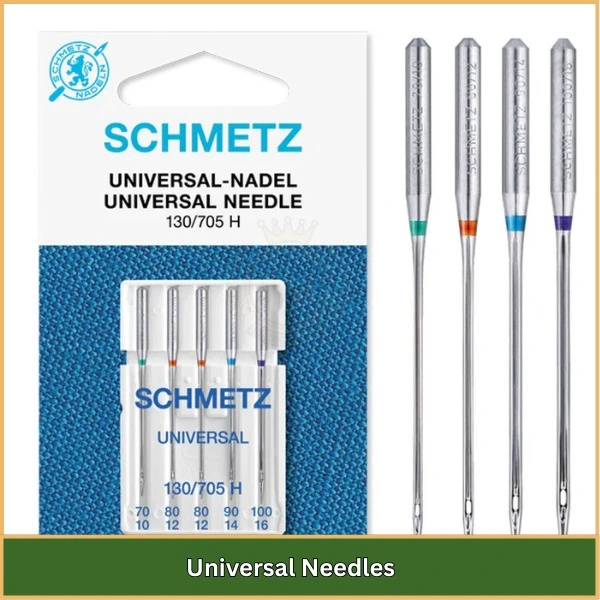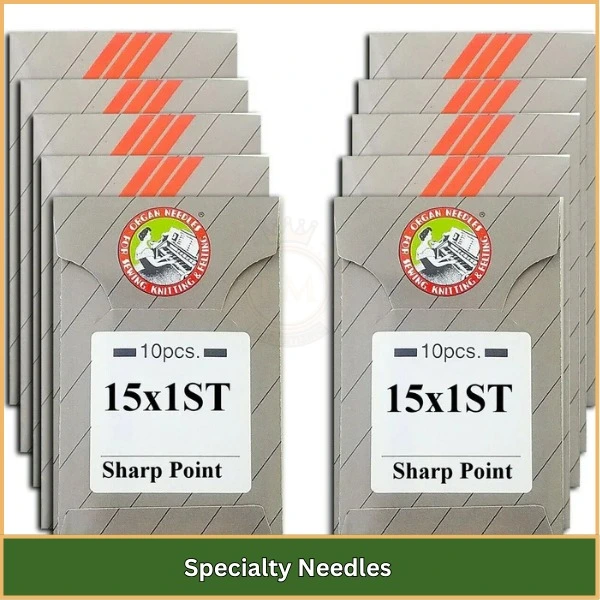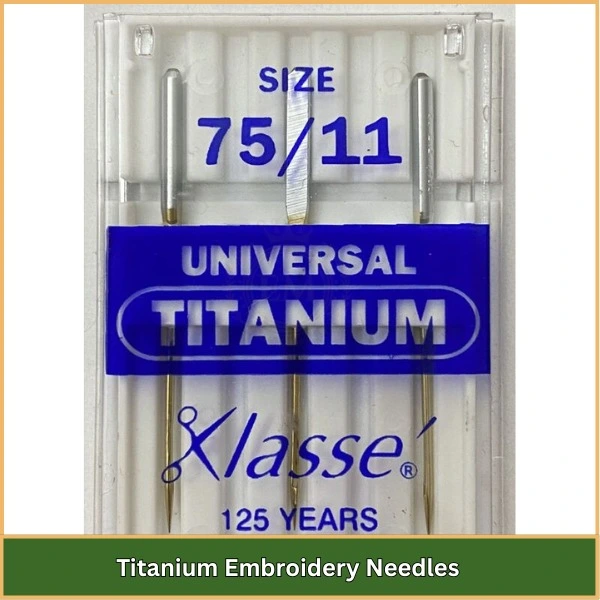Aghi da ricamo a macchina può sembrare una piccola parte della tua configurazione, Ma hanno un grande impatto su come risulta il tuo design. Se hai mai avuto thread che si rompono, Punti che saltano, o il tuo design sembra disordinato, Ci sono buone probabilità che il problema non sia il tuo tessuto o filo, era l'ago.

Ho visto molti principianti incolpare la loro macchina o file digitalizzato quando le cose vanno male, Ma il vero problema era semplicemente la scelta dell'ago sbagliato. Ecco perché è così importante capire quale ago usare per quale tessuto, filo, e progettazione.
In questa guida, Cammineremo attraverso tutto ciò che devi sapere in modo passo dopo passo, Proprio come siamo seduti accanto alla tua macchina, Aiutarti a ottenerlo dall'inizio.
Come scegliere gli aghi da ricamo a macchina giusta?
Prima, Comprendi le parti di un ago

Prima di scegliere un ago, it’s helpful to know what it’;s fatto di. Ecco le parti che dovresti sapere:
- Stinco - Questa è la parte superiore che si adatta alla tua macchina. Di solito ha un lato piatto.
- Lancia - La parte lunga dell'ago. Il suo spessore ti dice la dimensione dell'ago (Piace 75/11).
- Occhio - Il foro in cui il filo passa attraverso. Gli aghi da ricamo hanno un più grande, occhio più fluido.
- Punto (Mancia) - Questa è la fine dell'ago che va nel tessuto. Può essere acuto o arrotondato.
Groove e sciarpa - Questi aiutano a proteggere il filo mentre si muove e consentono alla macchina di formare punti adeguati.
5 I principali tipi di aghi da ricamo a macchina
Vengono fatti diversi tipi di ago tessuti diversi e tipi di filo. Scegliere quello sbagliato può causare il triturazione del thread, punti saltati, o danni al tessuto.
Esaminiamo i tipi principali e spieghiamo quando usarne ciascuno.
1. Aghi da ricamo

Questi sono appositamente progettati per ricamo a macchina. Hanno un più grande, occhio più fluido che aiuta a prevenire la rottura del filo, Soprattutto quando si usano rayon o filo metallico.
- Progettato per Rayon, poliestere, e fili speciali
- Aiutare a ridurre l'attrito e il triturazione del filo
- Disponibile in diversi stili di punta: appuntito o a sfera
Aghi da ricamo sono un must se vuoi risultati dall'aspetto professionale.
2. Aghi universali

Gli aghi universali sono realizzati per il cucito generale e sono comunemente inclusi con le macchine. Hanno un punto standard, non troppo acuto o troppo rotondo.
- Buono per progetti di base e pratica
- Non è l'ideale per ricami delicati
- Può causare pause del filo con thread speciali
If you’;sta facendo un serio lavoro di ricamo, Questi di solito non sono la scelta migliore.
3. Aghi a sfera

Gli aghi a sfera hanno una punta arrotondata. Sono fatti per tessuti elastici o in maglia come magliette o materiale della maglia.
- La punta rotonda scivola tra i fili invece di perforarli
- Previene i fori e tirano i tessuti elasticosi
- Ideale per il ricamo su morbido, Materiali elastici
Questi sono fantastici se vuoi evitare tessuto dannoso pur ottenendo ricami puliti.
4. Aghi speciali

Questi sono realizzati per usi specifici, e include:
- Aghi metallici - Eye più lungo per un flusso liscio di fili metallici
- Aghi gemelli - Due aghi attaccati a un gambo, Utilizzato per doppia cucitura decorativa
- Aghi allungati - leggera curva e finitura liscia per tessuti elastici
- Aghi in pelle - punta triangolare fatta per perforare materiali spessi come la pelle
- Neghi trapuntanti - Progettato per passare attraverso più strati di tessuto e battuta
Ognuno ha un lavoro. Se il tuo progetto ha bisogni speciali, Scegliere uno di questi può fare una grande differenza.
5. Nego di ricamo in titanio

Gli aghi con rivestimento in titanio sono più forti e durano molto più a lungo degli aghi da ricamo regolari. Questi sono ideali per:
- Macchine da ricamo ad alta velocità
- Tessuti spessi o strati
- Sessioni di ricamo lunghe
A causa del rivestimento, Riducono il calore e l'usura, Mantenere i tuoi punti lisci e ridurre le pause.
Se hai avuto problemi con gli aghi piegati o attenuare rapidamente, prova a usare Nego di ricamo in titanio.
Cose da considerare prima di scegliere un ago per ricami
Scegliere l'ago giusto è più che semplicemente scegliere qualsiasi dimensione dalla scatola. Se vuoi punti puliti, flusso regolare del filo, e ricami dall'aspetto professionale, devi prima pensare ad alcune cose importanti. Ripassiamoli uno per uno.
1. Che tessuto stai usando?
Il tipo di tessuto decide quanto dovrebbe essere spesso o affilato l'ago.
- Se stai lavorando con tessuto leggero come seta, organza, o tulle, usare un ago più piccolo e nitido (come dimensioni 65/9 o 70/10). Questi tessuti sono delicati e possono essere facilmente danneggiati.
- If you’;stai usando tessuto elastico Come la maglia o lo spandex, Scegli un ago a sfera. La punta arrotondata scorre tra i fili senza tagliarli, che impedisce i buchi.
- Per tessuti medi come miscele di cotone o poliestere, UN taglia 75/11 o 80/12 ago da ricamo è perfetto per i design generali.
Se stai cucendo tessuto pesante Come il denim, tela, o asciugamani, andare per un ago più forte e più spesso (come dimensioni 90/14 o 100/16) Quindi può colpire il materiale senza piegarsi.
2. Che thread stai usando?
Non tutti i thread sono gli stessi, E l'occhio dell'ago deve abbinare il tuo thread.
- Fili di ricamo standard Come il rayon o il poliestere funzionano bene con gli aghi da ricamo regolari.
- Fili più spessi Come i thread di 30 peso o speciali hanno bisogno di un occhio più grande Quindi non si bloccano o si rompono. Un ago più grande come 90/14 Funziona meglio qui.
Fili metallici sono delicati e possono distruggere facilmente. Uso aghi metallici o di titanio che hanno un extra lungo, occhio liscio per aiutare il filo a muoversi liberamente.
3. Quanto è denso il tuo design?
Il numero di punti nel design influisce anche.
Se il tuo design è leggero e aperto, Un ago per ricamo normale (75/11 o 80/12) Farà bene.
Se il tuo design è denso con molti dettagli, Scegli un ago più forte come Nego di ricamo in titanio. Reggono meglio durante le cuciture lunghe o complesse.
4. Che stabilizzatore stai usando?
Il tuo stabilizzatore aggiunge uno spessore extra, e il tuo ago dovrebbe corrispondere al peso totale del tessuto + stabilizzatore.
- Per stabilizzatori leggeri, Soprattutto quelli solubili in acqua, usare un piccolo ago per evitare di strappare.
Per stabilizzatori pesanti Come la lacrima tagliata o multistrato, Scegli un ago più spesso che può gestire la maggior parte senza rompere.
5. La tua macchina è compatibile con la macchina?
Controlla sempre il manuale della macchina da ricamo. Alcune macchine per la casa funzionano bene con aghi da ricamo standard, ma altri, Soprattutto quelli commerciali, può richiedere sistemi di ago specifici (come dbxk5 o hax130ebr). L'uso dell'ago sbagliato può danneggiare la macchina o influenzare le cuciture.
Di che dimensioni dell'ago da ricamo dovresti usare?
Prima di iniziare qualsiasi progetto di ricamo, it’;è importante scegliere la giusta dimensione dell'ago. L'ago che scegli dovrebbe abbinare il tuo tipo di tessuto, Lo spessore del tuo filo, e la complessità del tuo design. L'uso della dimensione errata può portare a pause del filo, punti saltati, o danni al tessuto.
Usa il grafico qui sotto come guida rapida per selezionare l'ago migliore per il tuo progetto:
Dimensione dell'ago | Meglio per | Tipo di tessuto | Discussione consigliata |
65/9 | Dettagli fini, Lettere minuscole | Chiffon, organza, tulle | 60 WT o più fine |
70/10 | Disegni di luce | Cotone leggero, cotone trapuntato | 60–40 WT |
75/11 | Ricamo generale | cotone, biancheria, miscele di poliestere | 40 peso |
80/12 | Disegni densi | Twill, provato, denim leggero | 40–30 WT |
90/14 | Tessuti pesanti o filo spesso | Asciugamani, berretti, jeans | 30 WT o metallico |
100/16 | Uso pesante | Pelle, tela spessa, stabilizzatori multipli | 20–30 WT |
Questo grafico delle dimensioni dell'ago da ricamo ti aiuterà a diventare liscio, pulito, e risultati dall'aspetto professionale abbinando i tuoi strumenti con i tuoi materiali. In caso di dubbio, Inizia con 75/11, Funziona per la maggior parte dei progetti di ricamo standard.
Conclusione: l'ago giusto dà i migliori risultati
Ora sai quanto sia importante scegliere il corretto aghi da ricamo a macchina. Anche se l'ago è piccolo, Ha un ruolo importante nel modo in cui il tuo thread, tessuto, e il design lavora insieme. Quando scegli l'ago giusto per il tuo progetto, vedrai meno problemi, Niente più thread rotti, punti saltati, o disegni disordinati. Il tuo ricamo sembrerà più fluido e più professionale.
Ma ecco qualcosa che molte persone dimenticano: Il tuo design deve anche essere digitalizzato nel modo giusto. Se la digitalizzazione non corrisponde al tuo tessuto, filo, e ago, Anche il miglior ago non aiuterà. Ecco perché la digitalizzazione professionale è importante tanto quanto la scelta dell'ago.
Questo è dove EMDigitalizzazione può davvero aiutare. Sono esperti in digitalizzazione del ricamo e sapere come preparare il tuo design in base al tessuto esatto, filo, e ago che stai usando. Non dovrai più preoccuparti delle congetture. Si assicurano che il tuo design sia pulito e perfetto, Proprio dal primo tentativo.
E la parte migliore? Puoi prendere 50% fuori dal tuo primo ordine, Quindi puoi testare la loro qualità senza rischi. Anche la loro squadra è disponibile 24/7 Se hai domande o hai bisogno di aiuto.
Se sei pronto a rendere migliore il tuo ricamo e risparmiare tempo, Tentativo EMDigitalizzazione Oggi. Vedrai la differenza che la digitalizzazione professionale fa!
Domande frequenti
La migliore dimensione dell'ago per la maggior parte delle macchine da ricamo è 75/11. Funziona bene con regolare 40 filo da ricamo a peso e tessuti comuni come il cotone, biancheria, e poli miscela. Questa dimensione fornisce risultati fluidi ed è perfetta per la maggior parte dei design.
Per scegliere un ago per il ricamo, Per prima cosa controlla la luce del tipo di tessuto, pesante, o elastico. Quindi, Abbina lo spessore del filo e i dettagli del design. Un tessuto leggero con filo sottile ha bisogno di un piccolo ago, mentre un tessuto pesante o un filo spesso necessita di un più grande, Uno più forte.
Una dimensione 9 L'ago è più fine della dimensione 14. In dimensioni di ago, Più piccolo è il numero, più sottile l'ago. Dimensione 9 è buono per morbido, tessuti leggeri e fili sottili, mentre la dimensione 14 è per tessuto spesso o fili più pesanti.
Puoi scegliere l'ago di ricamo giusto guardando il tuo tessuto, filo, e progettazione. Per tessuti morbidi o delicati, Usa un ago più piccolo. Per tessuti elastici, Usa un ago a sfera. Per tessuti pesanti o design densi, vai con un forte, ago più spesso.
